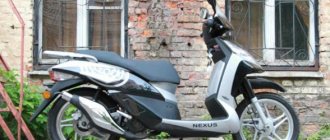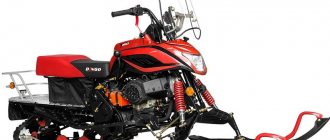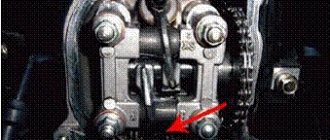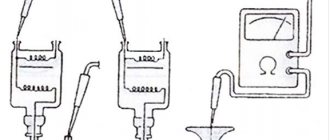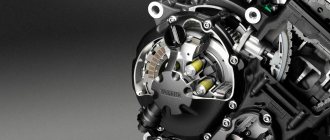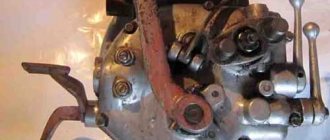Owners of Java motorcycles, in particular model 634, know firsthand how much suffering a native generator can bring. These are burnt wires, lack of normal headlights and eternal problems with ignition. To avoid this, you can install the scooter ignition in Java and forget about your problems.
Advantages of ignition from a scooter on Java 634:
- Stable operation of the head light;
- Ability to start the motorcycle even with a discharged battery;
- 12 volts;
- By installing cdi ignition on Java, you get built-in ignition timing adjustment;
- More stable operation of all electrical-related systems;
- Relative simplicity of motorcycle conversion.
Flaws:
- Cost of a complete set of re-equipment;
- It is necessary to redo all electrical systems to 12 volts;
- Requires special skills, such as knowledge of motorcycle wiring.
BSZ (Contactless Ignition System) on Java 638
After purchasing and using the Java bike for the first week, I felt that the Java was a beast (my first motorcycle), but almost immediately the problems began after the previous owner, the spark plugs died, or the boiler did not work. I read day and night about BSZ, because I was tired of the contacts, especially since it was time to change them because in 20 years the entire ignition system had worn out. Well, the other day I met Yavist in our town and he had a BSZ. I decided to install it for myself. First I had to buy a Switch from VAZ 2108 – 250 rubles. Hall sensor VAZ 2105-2108 – 95 rubles. Bundle of wires for BSZ from VAZ 2105 – 100 rubles. 2-output coil – GAZ 406 engine (Gazelle, Oka) from 300 to 550 rub And so, everything is there, let's get started 1. Cut out the modulator from the alloy (for starters, you can use steel (iron), for long-term use brass is better). There are 2 types of modulators for BSZ
The plate can be set for the first time (I’ll explain why later), but almost everyone leaves it as the main one. When using this modulator on a perfectly warmed-up engine of the YAVA 638 bike, twitching begins (3-4 jerks when accelerating from low speeds in high gear)
with such a modulator there are 2 options, depending on the driving style, either it rushes like a tank (not bad behavior at the bottom, the dynamics of the Amica, the speed is lower), or it flies like an airplane (that is, the behavior at the bottom is not very good, at high speeds it’s excellent)
Naturally, you can install a modulator from a VAZ (CUP), but few install it.
After we have cut out the modulator, we prepare a platform for the DH (HALL Sensor). If it is possible and you don’t want to waste time, you can try to select a certain number of washers so that the modulator passes through the DH and does not touch it either from above or from below.
Before installing the modulator and DC, it is necessary to remove everything from the pad on the generator (cams, pads, pull out the pin for the cam because it will interfere with the rotation of the modulator.
to install the BSZ there must be an empty surface on the generator. Almost everyone installs the DH on 2 bolts on the lower left side of the generator, which is true, for proper installation we remove the platform on which the cams were attached, etc. and drill a hole with a diameter of 4 under the DH so that the DH It fits perfectly on them, but the bolt must go in (screw in (cut thread 5) so as not to touch anything inside the generator.
We place the modulator on the central bolt of the generator, the DH on 2 bolts, now we can create ignition control using 2 methods - by turning the platform or by turning the modulator.
Now we’re sorting out the wiring.. There won’t be any problems connecting the bundle of wires, there should be 3 more wires left on it, we put the black one on MASS, connect the gray-red one to the blue one (which was connected to both reels earlier) and shove it into the bobbin, making a preliminary connection on the MAMA wire ,The second wire is also inserted into the reel.
We insert the Key, start it, it won’t start))) this is normal, we remove one high voltage, put a foreign spark plug on it (to be sure), and now actually why it won’t start, you don’t need to be scared, it’s normal, you just need to swap the wires on the Brushes, everything is ready , start it up, let it run on one cylinder, turn it off later, remove the cap from another spark plug, put it on a foreign one, and put the one that was hanging on the cylinder that was previously turned off, start it up. let it work a little, turn it off, put both caps on the space, literally adjust the ignition and rejoice
WHAT YOU CAN'T DO NOW:
If you pull off the high-voltage switches while the motor is running, they will immediately break through.
I would like to install the same system on my Java, the spare parts have now arrived, I will install it! Maybe someone who installed it can share their experience!
Source: www.mopedist.ru
Electrical diagram
The electrical circuit of the YAVA 638 has been modernized based on the wiring of the previous model. The experimental 12-volt equipment was completely replaced and required the installation of a larger battery. Features of this innovation:
- the appearance of a 210-watt generator;
- possibility of installing an additional fog lamp;
- The stroller consumers were provided with current from a standard generator.
Thanks to the new system, the level of luminous flux was increased, which ensured driving safety at night. Spark formation has also improved, which contributes to more uniform and dynamic engine operation.
The new generator contains such basic elements as a rotor, stator and a metal casing. Its efficiency significantly exceeds the previously used 6-volt generator. This system allows charging even when the engine is running at low speeds.
However, the created system generated direct current, which needed to be converted into alternating current. For this purpose, a rectifier was built into the system. Its convenient location under the saddle makes it easy to carry out maintenance yourself.
However, when installing such equipment, the problem of overheating of the generator walls arose. It became impossible to use the rectifier inside a metal casing, so it was located under the driver's seat, providing air flow to cool the system.
The permissible power to a temperature of 150 degrees Celsius was 15 amperes. With the stroller and the use of all devices, it became possible to connect one additional consumer that does not require more than 40 watts of power.
Advantages of BSZ relative to KSZ
When writing the article, I sat and thought and thought, and still did not come to a conclusion about what exactly is the main advantage of BSZ; for me, all the advantages listed below are the main ones and are equal to each other.
– Highest stability of the engine (synchronous operation of the cylinders, right in turn)
– Quick response to the throttle
– The best motor thrust (which allows you to easily use the largest drive stars without difficult acceleration!)
– Candles “live” four times longer than at KSZ (I’ll write about this separately below)
– Less recognizable “snot” from Java mufflers (because fuel and oil are burned much better)
– Longer service life of all crank bearings (because there is less third-party detonation and vibration)
– Less fuel consumption (because it burns out better, the carburetor needs to be adjusted to the lowest fuel supply)
Types of BSZ
There are two types of BSZ:
– Single-channel (one Hall sensor, two-lobe modulator, one switch, one two-terminal ignition coil operating on two cylinders at once)
– Two-channel (two Hall sensors, one, or better yet two, modulator lobe, two switches, two ignition coils, one working on each cylinder)
It is better to install a specifically single-channel system, because it will be more stable, because here you do not have to adjust any cylinder (which you have to do at the KSZ), here, if the modulator is manufactured correctly, then only one cylinder is adjusted. Also, in a single-channel one, fewer wires are used, its parts take up less space, and energy consumption is lower (which is very important for 6-volt generators)
There are many people who like to “get confused” who install a two-channel one, shouting at the same time that this way they can configure it more precisely, etc. I assure you that these are unnecessary hassles, and there will be no accuracy here (which is why it is stated above)
Spark plugs. I said above that spark plugs “live” longer, which begs the question “Why?”
Essentially the answer is simple. If you decide to install a single-channel BSZ (or a two-channel one with a two-lobe modulator), then this is what will happen:
When igniting in one cylinder, in the other, with all this, a spark will also strike at BDC, because it strikes on both spark plugs at once, in other words, spark twice per revolution on each spark plug.
What does this give? This allows for warming up and cleaning of the spark plugs at that moment the pistons are at bottom dead center, we get the smallest temperature difference of the spark plug electrodes (not allowing it to cool) and clean electrodes, ready for the new ignition of the fuel mixture. These reasons, as practice has shown, increase the service life of candles.
INSTALLATION OF BSZ
To do this, you need to prepare the following in advance:
– tools: screwdrivers, pliers, hammer, anvil, multimeter (preferably electric), a narrow ruler (up to 10mm wide) or calipers, ratfile and needle files
– parts: switch (VAZ-2108), Hall sensor, connecting wiring harness for them (ready-made for sale), two-terminal ignition coil from Gazelle or Oka, modulator (butterfly is made of a magnetic alloy 0.7-1 mm wide according to the drawing below) high-voltage wires (armored wires) of the highest power (preferably silicone)
1.Initial stage
First, let's make a modulator if you haven't already made one. The easiest way to create this is to print out the drawing in real size (the dimensions of the drawing correspond to real measurements), glue the printout onto an iron plate and cut out a modulator along the contours of the drawing. ATTENTION. Accuracy down to mm is key here! So it is not permissible to allow any “in-your-face” behavior here. The edges of the modulator need to be processed with a needle file so that there are no nicks or burrs.
2.Dismantling
– Disconnect the high-voltage wires from the spark plugs.
– Disconnect the inductor wires from the ignition coils
– Remove the ignition coils along with the high-voltage wires (we will no longer need this)
– Disconnect the capacitors from the breaker contacts
– Disconnect the inductor wires from the breaker contacts
– Remove the contacts from the ignition plate
– Remove all screws from the ignition plate and remove it from the generator
3.Preparation
– Place the anvil on a level surface
– Place the ignition plate on the anvil and smooth out all the creases with a hammer, and remove the breaker pins with pliers
– Remove the generator rotor bolt
4.Installation
– Hang the 2-pin ignition coil in a convenient place under the tank
– Connect wires 1 and 4 of the switch to the coil as shown in the diagram, also high-voltage wires to the spark plugs (ATTENTION: DO NOT USE HIGH-VOLTAGE WIRES FROM YOUR OLD COILS. FOR ELECTRONIC IGNITION YOU NEED POWERFUL WIRES, PREFERABLY SILICONE, Sold AVAILABLE IN ANY CAR STORE! )
– Screw the modulator to the rotor with a regular armature bolt
– Attach the Hall sensor to the plate as shown in the photo
– Mount the switch in a place that is comfortable for you (it is recommended to install it on the right cover of the air cleaner directly under the facing cover)
– Lay the connecting wires of the switch and the DC and connect to the switch and the DC
– Ground wire 2 of the switch to the bike frame (do not ground to the tank!)
5.Adjusting the ignition timing (IPA)
5.1. Set the left piston to top dead center, and using a ruler (or caliper) move the piston back 3mm
5.2. Loosen the generator bolt securing the modulator (ATTENTION DO NOT ALLOW THE SMALLEST ROLL OF THE CRANKSHAFT.)
5.3. Connect the multimeter like this: the reddish clamp to the greenish wire of the hall sensor (at the input to the sensor from the greenish wire you need to move the snow-white heat shrink and gain access to the exposed wire), and power the dark clamp of the multimeter to ground (for example, to the engine crankcase)
5.4. Set the multimeter to voltage reading mode in the range of 0-20 volts
5.5. Turn on the ignition (the multimeter should show a value either equal to or close to zero)
5.6. Very slowly turn the modulator so that its alloy enters the Hall sensor while doing this, do not take your eyes off the multimeter!
5.7. As soon as a reading of 4-12 volts appears on the multimeter, stop rotating the modulator, and turn it even more slowly in the opposite direction so that the device just shows zero again!
5.8. Tighten the alternator bolt WITHOUT TURNING THE MODULATOR AND CRANKSHAFT!
5.9. Again, check the position of the piston and double-check the position of the modulator and the readings in this position of the device when tightened; if the readings deviate, then adjust by loosening the screws securing the plate with the DC and slowly rotate the entire plate until the readings become correct.
5.10. Check the readings for the right piston, only if the readings differ, do not move anything from its place (neither the plate nor the modulator), but use a file to sharpen the edge of the modulator that enters the Hall sensor at this moment.
6.Start
– If your bike has a float suppressor on the carburetor, then press it and hold it until fuel starts to drip from the carburetor, but if your motorcycle does not have a float suppressor, but has a cool start mechanism (for example, a Mikuni or Jikov carburetor as on Java 638), then lift flag and pump up three or four times using kickstarter.
– Insert the key into the “ignition” position and sharply pull the kickstarter
If you have the Internet at normal speed, then take a look at our three videos on BSZ to make it more clear how all this is done, including on a bike with 6-volt electrical equipment!
Source: extreme.newline.by
Setting the ignition timing
The ignition is adjusted in order to obtain a spark at a certain point in time. In the case of fixed stator coils, the magnet-rotor rotates to the required position relative to the crankshaft journal. The keyways are sawn through in those patterns where the rotor is attached to the key.
In systems with sensors, their position is adjusted.
The ignition timing is given in the engine reference data. The most accurate way to determine SOP is to use a car strobe light. Sparking occurs at a certain position of the rotor, which is marked on the stator and rotor. A wire with a clamp from the switched on strobe is attached to the high-voltage wire of the ignition coil. After this, the engine starts and the marks are illuminated with a strobe light. The position of the sensor changes until all marks coincide with each other.
Installation of BSZ on Jawa-638
I apologize for the repost, this article is lying around in bundles on the internet, but when I need it I can’t always find it in the usual version with all the pictures, and at the moment I’m just installing BSZ on my own Boberly RX1, so I decided to post it on the blog so that was always at hand.
Installation of BSZ on a Java-638 generator
STEALING I saddled my first Jawa ten years ago and since that time I have remained an admirer of Czech technology. But in recent years, the increased need to constantly find spare parts has shaken my attachment. Well, their property became simply “none.”
Including the ignition system breaker. It is crammed with nothing but troubles: either the contacts burn up “in smoke” within a few miles of driving, then for some unknown reason the painstakingly adjusted gaps “float away” from the required dimensions in a couple of days, the spark plug spark gaps are covered with “the devil” and completely refuse to spark. With such a “lighter”, driving turns into fidgeting and endless repairs. Add to this a battery that has dropped by two or three volts, and with it, starting a cool engine turns into torture.
RUSSELLING The publication in Moto (N9-2001) about the non-contact ignition system (BSI) of Jupiter-5 helped free the ignition from defects: installing a similar circuit turned out to be a matter of just one day. The only “author’s” part, invented by me, is the supporting platform of the Hall sensor, and that one was borrowed from the bearing of the vacuum corrector of the “Volgov” ignition distributor.
Contactless ignition system: 1 - battery; 2 — ignition switch; 3 — spark plugs; 4 - two-terminal ignition coil; 5 - voltmeter; 6 - switch; 7 - Hall sensor.
The performance of the Jawa engine equipped with BSZ has become completely different and, I would add, pleasant to the pilot. The sound of the engine has acquired the required softness; at idle speed it simply rustles. The “steel” notes inherent in the occurrence of glow ignition and detonation have completely disappeared. The bike obeys the throttle perfectly and responds to the opening of the throttle with a quick increase in speed. The engine starts smoothly even with a quarter-discharged battery.
But the circuit seemed overloaded to me: I think two stripes “sensor - switch - coil” are unnecessary. I simplified the BSZ. “Double” parts become unnecessary when using a two-terminal coil and a symmetrical shutter modulator. In my circuit, the coil discharges to both spark plugs at once. In one of the cylinders, the spark coincides with the intake-compression stroke and ignites the working mixture, in the other it occurs during the working stroke - exhaust and is wasted. But a massive “electrical” discharge is more than enough for both cylinders. By the way, ignition components have become half cheaper: from 680 to 350 rubles.
Extreme.Newline.by
Motorcycle engines have either constant or variable ignition timing . With constant ignition timing , the beginning of the breaker break, and, consequently, the appearance of a spark, remains unchanged in all engine operating modes. With variable ignition timing, the moment of spark appearance is changed manually or automatically - with a centrifugal regulator, which, as the speed increases, increases the ignition timing from 10 to 30°. (see continuation)
In domestically produced motorcycles, the ignition timing according to factory data:
For two-cylinder engines M-61 and K-750, the breaker cam is a continuation of the camshaft, so the ignition timing is set at the factory. These machines have the same hammer break value for the right and left cylinders.
- - hole for decompressor;
- - rod for determining c. m.t.;
- — fixed contact of the breaker;
- — breaker lever;
- - fist.
BSZ to Java 638
Ded140 Senior Member Topic creator
| 8 years on the website user #451748 I understand that the topic has already been heard 100 times and they will send me to Google, but I’m asking KNOWLEDGEABLE guys to explain what’s what. I ask you to write a list of what exactly is needed (preferably with a photo and, if possible, with photographs), but the more thorough the better. Effort is not enough to achieve the goal. Naumbl4 Senior Member |
| 9 years on the website user #311284 . uh in Java ru, everything is chewed up izerli Senior Member |
| 9 years on the website user #315974 Ded140 , which specific BSZ? From Zhigov's tsatsek or the Minsk gene? I put it together according to the scheme from Zhigov’s tsatseks into a motorcycle and nothing works for me, although it works for others. Skomoroh Senior Member |
| 14 years on the website user #36696 izerli , I still forgot the optical one. izerli Senior Member |
| 9 years on the website user #315974 Skomoroh , Oh yes. feet in my mouth. Naumbl4 Senior Member |
| 9 years on the website user #311284 when Java was collected from Zhigava trants, it worked on it and others like it, and it seems like 6 in Java izerli Senior Member |
| 9 years on the website user #315974 But still the branch lives. Cams, capacitors are a thing of the past! And now it's not high quality. Well done Ded140 , constructive! Naumbl4 Senior Member |
| 9 years on the website user #311284 Yes, how I remember the micrometer at the moment, the fists that were playing around...ooohhh izerli Senior Member |
| 9 years on the website user #315974 or capacitors - xs. some are normal and some are not. Skomoroh Senior Member |
14 years on the website user #36696
In Java it was made from Lada parts, because... It was impossible to find high-quality cams even then. On the boxer, where high-quality cams were obtained, the cam worked unsurpassed. So it's not a matter of design. Ded140 , there is such a person - Roma Fakn Mad, on the L_R onliner. Contact him, he can create a BSZ for money. Ded140 Senior Member Topic creator |
| 8 years on the website user #451748 I think something from the Russian “Magic of Automotive Equipment”. I am interested in a certain model of equipment, certain sizes of records and all that, even better with the prices for these products. Java 638. I will assemble the BSZ myself, but I don’t understand or understand anything. explain everything as thoroughly as possible plz)) and so that everything is CHEAPER. I understand sarcasm.. but plz))) Effort is not enough to achieve the goal. izerli Senior Member |
| 9 years on the website user #315974 Ded140 , coil for electric ignition from Volga, switch, Hall sensor, harness. The prices at the moment are bad, I don’t understand them clearly. skif1905 Senior Member |
| 10 years on the website user #191690 So find someone to do this for you. Or buy a book on the theory of the internal combustion engine, read it and then we’ll talk further. Ded140 Senior Member Topic creator |
| 8 years on the website user #451748 You will need to purchase: 1. a two-channel ignition coil (Oka car), 2. a switch from VAZ (*.3734), 3. create a curtain modulator (according to the dimensions of the OP already installed on the generator) 4. and a set of wires ( This is not for everybody, you can make do with your own) 1. two-channel ignition coil (Oka car), 1.1. ignition coil from VAZ 2108 for example 27.3705 2. switch from VAZ (*.3734), 2. 1. switch from VAZ 2108 for example 76.3734 or 0529.3734 or some other. 3. 4. connecting wires for BSZ from VAZ without EPHH for example like this. I compiled it from a search engine. - correct me if something is wrong Effort is not enough to achieve the goal. Wofka Bolt Member |
| 11 years on the website user #154614 For a fee, I’ll install and set it up! I’ll select high-quality components! I will also convert the 6V Java to 12V General IZH. Ded140 Senior Member Topic creator |
| 8 years on the website user #451748 You will need to purchase: 1. a two-channel ignition coil (Oka car), 2. a switch from VAZ (*.3734), 3. create a curtain modulator (according to the dimensions of the OP already installed on the generator) 4. and a set of wires ( This is not for everybody, you can make do with your own) 1. two-channel ignition coil (Oka car), 1.1. ignition coil from VAZ 2108 for example 27.3705 2. switch from VAZ (*.3734), 2. 1. switch from VAZ 2108 for example 76.3734 or 0529.3734 or some other. 3. 4. connecting wires for BSZ from VAZ without EPHH for example like this. I compiled it from a search engine. - correct me if something is wrong For a fee, I’ll install and set it up! I’ll select high-quality components! I will also convert the 6V Java to 12V General IZH. I have a faceplate for transition to 12V equipment from Java 638. I forgot to add, OP and FUOZ will do it for me. (I am making a FUOZ board (as in the picture) - 150 thousand and an opto-sensor (OP) - 50 thousand) Source: forum.onliner.by |
What will you need?
To install the ignition from a scooter in Java, we will need a specific conversion kit. First of all, there is the generator itself; there are two models to choose from. The simpler QMB-139 will perform all the necessary functions, but problems may arise with the light at night, since the winding for the head light is rather weak and will greatly depend on the speed. If this parameter is important to you, then choose a stator from the QMI-157 or 152QMI model - they will be sufficient to achieve your goals.
You will also need an ignition coil with two terminals, here again there is plenty to choose from. For our purposes, motor coils ZMZ-406 or from Oka are suitable.
You will need a 12 volt battery. We don't need a new one; any used motorcycle or new Chinese battery will do. Its role is to smooth out voltage drops in the turn signal and stop signal circuits.
Also, do not forget about the set of wires/terminals. It is better to take the latter from Japanese scooters.
The last item is the adapter plate. Alas, it cannot be found on sale, but kind people have prepared the exact drawings presented below, according to which you can assemble your own adapter plate or order it. The thickness of the metal is 4 mm, this is an important parameter, because if you make the plate larger or smaller, some elements of the system may not fit or work incorrectly.
To watch online, click on the video ⤵
inexpensive BSZ set for Java (Jawa, Cezeta 501) More details
INSTALLED BSZ on Java 638 (634) 350. More details
Installation of the SoveK LLC Contactless Ignition System on a YAVA bike. Part 1. Read more
CONTACTLESS IGNITION SYSTEM for Java 638 (634) 350. More details
BSZ INSTALLATION JAWA JAVA 350 638 634 IZH ELECTRONIC IGNITION SYSTEM Read more
Installation and adjustment of BSZ Saruman on a Jawa 350 638 bike Read more
Java electric ignition setting 634-638 (BZS) Java 350 Read more
Installation of the SoveK LLC Contactless Ignition System on a YAVA bike. Part 2. Read more
installation of ignition with a hall sensor on a bike. BASHKIRIA STERLITAMAK Read more
Overview of the BSZ Jawa 638 installation Read more
electric ignition in reality 350 638 More details
adjustment and repair of motorcycle JAWA 638 Java (electric ignition. carburetor) Read more
contactless ignition IZH Jupiter 5 Read more
How is BSZ better than contact ignition? Read more
It can't be! It is so simple! Checking the Hall Sensor. More details
Setting the ignition in Java with free Read more
Java errors according to BSZ Read more
BSZ with variable OZ for 634 engine with 12V generator. More details
INDEPENDENT PRODUCTION OF IZH PLANET MOTORCYCLE IGNITION SYSTEM MODULATOR Read more
Source: putinizm.ru
What to do next?
Most likely, the ignition you assembled from a Java 634 scooter is rough and consists of twists, which is why you should replace them with normal terminals and twist the wires into braids. There is only a small matter left to do - completely replace all the remaining electrical elements, starting from the dashboard and ending with the head lighting and turn signals. Fortunately, now you have full 12 volts, so you can replace everything with spare parts from older models. On the other hand, 12 volts open up the opportunity to install almost any modern turn signal, high-quality lighting and many other useful devices such as a charger for a smartphone or an on-board audio system.


